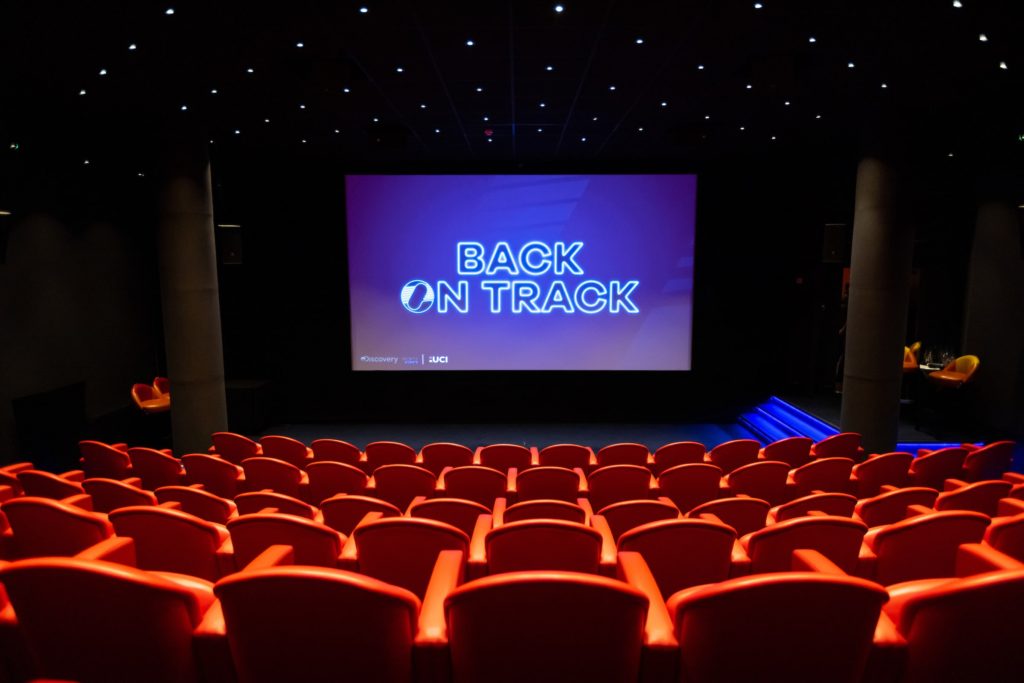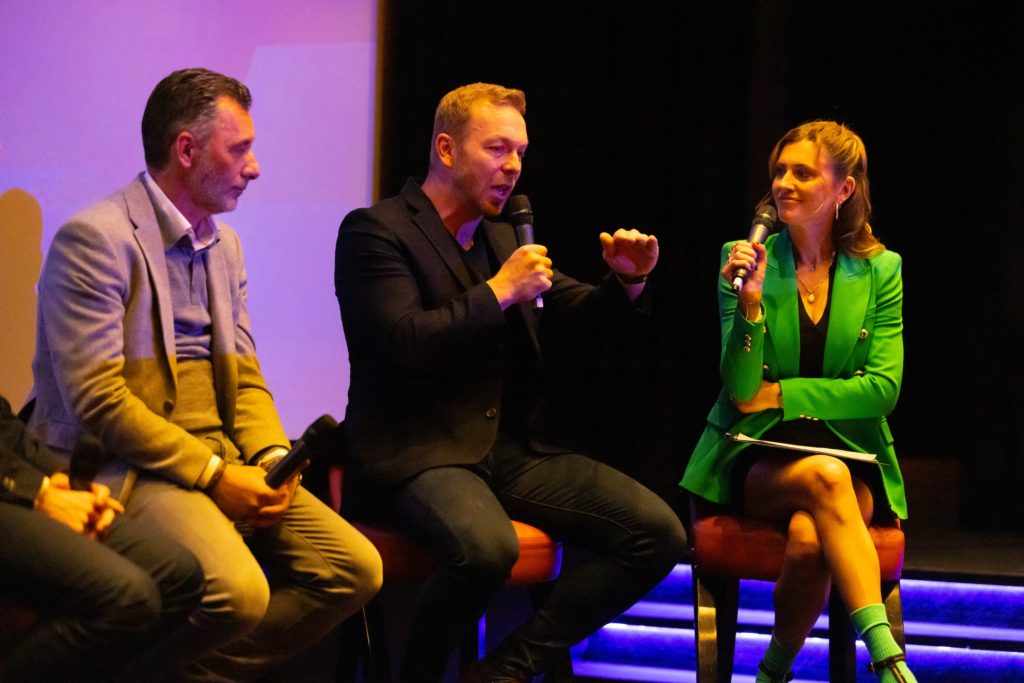Back On Track: Track Cycling’s Own Drive To Survive

As he takes his seat in the theatre of The Soho Hotel, Chris Hoy has a smile that goes from ear to ear.
He is joined by Francois Ribeiro, the Head of Discovery Sports Events, who is also eagerly awaiting the premiere of their new docuseries.
Titled ‘Back on Track’, the five-part series covers the first year of the Track Champions League, the Union Cycliste Internationale’s new competition, and allows viewers to see what work went on behind the scenes.
For Hoy and Ribeiro, this is a project that has been years in the making.
“The likes of Drive To Survive and also the Last Dance have opened a new door for storytellers in sports,” says Ribeiro. “Producing a docuseries on the Champions League was a decision we took very early.
“That was three years ago, probably during season one of Drive To Survive. But we understood that that way of narration in sport is becoming so important and will become increasingly important.”

The Drive To Survive Influence
These types of series have become increasingly common in sports recently. Ribeiro mentions two of the most popular, and Amazon’s All Or Nothing series has also proven to be a hit.
The one that draws the most comparisons is Formula One’s Drive To Survive. But not only because both sports include racing around a track.
Formula One found itself at a plateau before the release of Drive To Survive. Despite being a popular sport for decades, it was struggling to recruit the next generation of fans, and also finding it hard to gain popularity in the United States.
Since the Netflix series first premiered in 2019 though, the sport’s popularity has ballooned. The documentary’s viewership has increased every year since the series has aired, with over four million people tuning in for the opening weekend of the last series.
Its popularity is a major reason why two further races in the States are planned. One in Miami. And one in Las Vegas in 2023.
But the most significant achievement for the series has been how it has attracted a new, younger fanbase. Something which Hoy and Ribeiro are both hoping Back On Track can emulate.
“The people who are watching Formula One now, a lot of them did not really care about motor sport at all,” explains Hoy. “And their first interest in motor sport is through this documentary.”
A Need To Raise The Profile
Track cycling’s main source of viewership has traditionally come every four years at the Olympic Games. Outside of this, it has struggled to maintain high levels of attention.
As a six-time Olympic champion on the track, Chris Hoy is all too aware that the profile of the sport he loves is in desperate need of a boost.
“I would have loved it back when I was competing because you fell in love with the sport as a kid and you want to tell the world about it,” Hoy says.
“When I first started competing for Britain, I’d be in a taxi or whatever and they’d ask, “So what do you do?” And I’d say, “I’m a professional cyclist.” And they’d go, “what like a courier?”
“Back in the day people had of heard of it and the Olympics and the Tour de France in Britain has really elevated the sport. But there’s lots of other countries around the world that have absolutely no idea what track cycling is.”
The Pitfalls Of Docuseries
Although these types of series have proven in the past that they can boost a sport’s popularity, they have not been without criticism.
In the most recent season of Drive To Survive, the series was criticised for manufacturing narratives between drivers.
McLaren teammates, Lando Norris and Daniel Riccardo, were videoed laughing about how parts of the series were put together in a way that did not happen purely for the sake of creating drama.
Max Verstappen has even refused to take part in the series because of the way it has created fake rivalries.
The lack of authenticity has seen audience ratings for Drive To Survive plummet, with the audience score on popular film and TV review site Rotten Tomatoes dropping from 91% for season one to 15% for season four.
Authenticity is something that Back On Track must maintain if it is to keep viewers hooked. But having genuine stories is something that does not concern either Hoy or Ribeiro.
“We gave a white card to the editors and the producers,” says Ribeiro. “We just told them, “look you don’t need to overact it. Just only show the sport the way it is.”
“If you are close enough and if you gain the trust of the riders, I think that will feel authentic.”
Hoy, likewise, explains that the riders are happy that there is an interest in both their sport and their livelihoods. That is what he believes will keep the series genuine.
“This is them being real,” he says. “There is nothing to hide. They’re not trying to portray something they are not. They’re just delighted that people are showing interest.”
A Diluted Market?
The other fear that comes with putting a series like this out is that every sport now seems to be doing something similar.
Netflix are planning on releasing a series about the PGA Tour, and the same company that produces Drive To Survive will be making a docuseries about men’s and women’s tennis.
With these types of series becoming so common, the question is why should people tune in to watch Back On Track? What will it offer that a similar series about a different sport won’t?
“I guess you could say there’s a risk of jumping on the bandwagon,” says Hoy. “But I think it’s only jumping on the bandwagon if there’s nothing of real merit or substance. We’ve got so much of it.”
For Ribeiro, the selling point is that the series will be providing stories from all riders up and down the track.
“I’m very curious to see what PGA do,” he says. “Because I am expecting stories which I don’t know to come out in that documentary.
“I think it’s important to bring those stories to life, but it’s also important not to overdo it. Because as soon as you overdo it, you see the reaction from fans and the athletes immediately.”
Taking The Track Champions League Global
Should the series be a success though, there is real potential for track cycling to grow.
The way it might benefit future seasons of the Track Champions League is recognised by both Ribeiro and Hoy.
“The intention is still to go global,” explains Ribeiro. “I think season two will still be very much Eurocentric. But we will export the Champions League outside Europe that’s for sure.
“It’s a marketing tool to tease the following season. The way we are going to promote it will be global because a few months from now, Discovery Plus will merge with Warner which will give us the biggest platform in the world.”
Despite the concerns raised about the series as the chat comes to a close, the optimism that both Hoy and Ribeiro had when they first sat down is still there as they get up to leave the room.
There is real confidence that this will make the difference to a sport that is looking to find a higher gear and thrive. If it is a hit, then there’s no reason to say why the UCI can’t sell out arenas for their new competition around the world.
Back On Track is available to watch on Eurosport Player and GCN+ (available later on discovery+*), with new episodes released every week.
To read more articles from the same writer, click here.